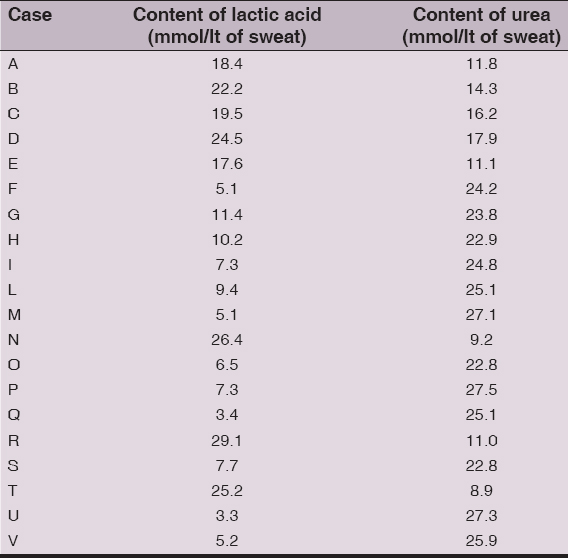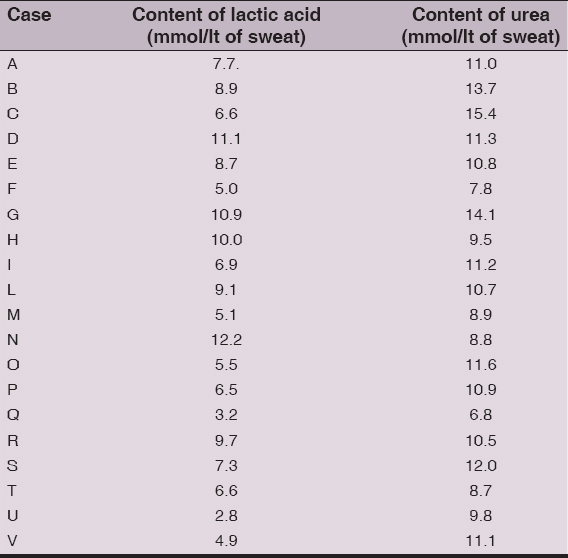Vitriols do guarantee an efficacious reduction of the human sweat when secreted from eccrine glands
Lorenzo Martini
University of Siena, Department of Pharmaceutical Biotechnologies, Via A.Moro 2, 53100 Siena, Italy
ABSTRACT
Introduction: Eccrine glands in human body are designed to secrete a salty solution containing variable percentages of urea and/or lactic acid and/or lactates.
Aim: We want to demonstrate that it is possible to determine the preponderance of the former or of the latter in order to achieve the astringency of the same eccrine glands using vitriols, that is white or blue vitriol (zinc sulphate or copper sulphate).
Results and Conclusion: The results are really thrilling, and it is suggestive to notice that gymnastical exercises and climate temperatures may or not influence the production of urea and/or lactic acid, nevertheless vitriols are exceptional to achieve the desired expectations, as far as astringency and anti-perspiration is concerned.
Key words: Blue vitriol, White vitriol, eccrine glands, sweat urea, sweat lactic acid
INTRODUCTION
In man, sweating is chiefly a means of thermoregulation which is achieved by the water-rich secretion from the eccrine glands, which are the major sweat glands of the human body, found in virtually all skin and produce a clear, quasi-odorless substance, consisting primarily of water and chlorides of Sodium and Potassium, urea and lactic acid. Maximum sweat rates of an adult can be up to 2–4 liters per hour or 10–14 liters per day (10–15 g/min•m²). Evaporation of sweat from the skin surface has a cooling effect due to evaporative cooling. Hence, in hot weather, or when the individual’s muscles heat up due to exertion, more sweat is produced.
We are well acquainted with the fact that 20-minute stay in a climate chamber at 40°C (e.g. an hammam) results in a 5 % reduction in body weight [1], by means of a production of a copious sweat extremely rich in urea and chlorides. The same body weight loss can be induced by the same period of time occupied by running exercise, even if during exercise human sweat is richer in lactic acid and sodium lactates than urea and chlorides [2]. Objectively it must be stressed that sodium and chloride concentrations anyway result much lower in the sweat induced by thermal exposure than that induced by the running exercise (p <0.01), while urea concentrations are significantly higher after thermal exposure than after the running exercise (p <0.01). Potassium concentrations do not differ significantly with either procedure. These findings suggest that sweat composition varies with the kind of induction and that more salt seems to be lost through exercise induced sweating than by just sitting in a hot environment.
On the other hand [3-5) it has been observed that 15 min of exercises (e.g.:cycling) at different temperatures give raise to elevated pools of lactic acid and sodium, meanwhile the pool of urea remains constant, at whichever temperature the gymnastic exercise is performed.
Notwithstanding these general and empirical rules, there is an avalanche of physical-chemical variables that must kept in consideration when one decides to find a way of abating the secretion of eccrine glands: first of all the diet that can be rich or poor in minerals and abuse of spices, the individual’s skin pH, his age and the drugs he uses to take.
Anyway, exercise, like running or cycling, especially when marathoners or pedalers practice their sport during hot temperatures and wear lycra pants, may produce an enormous quantity of sweat by the eccrine glands, and the pool of lactic acid and/or urea must be anyway determined case by case, in order to find a real solution to exert an astringency with regards to the eccrine glands, when they tend to produce more urea than lactic acid or vice versa, for causes that do not pertain this dissertation.
The phenomenon of astringency is the mirror opposite of the phenomenon of inflammation: as inflammation is characterised by hyperaemia with redness, hypersensitivity connected with sensation of pain, increased and altered permeability of the cell membranes and of vasal endothelia accompanied by oedema and exudation, so astringency is characterised by its capability to coagulate the upper layers of epidermal tissues letting the permeability of cell membranes decrease with the subsequent obstacle to the exchanges between cells and extra cellular liquids and vasoconstriction of arterioles and capillaries pertaining to the same eccrine glands.
It must be even considered that a hyperproduction of lactic acid, that tends to remain onto the stratum corneum of the epidermis, may be considered a severe source of inflammation, and thus white vitriol (zinc sulphate) is advisable amongst all the types of astringent substances, since it behaves as an excellent anti-inflammatory agent [6,7].
On the other hand, when urea, hyperproduced by eccrine cells, tends to remain onto stratum corneum of the epidermis, it risks to dissolve the intercellular matrix of the cells of the same stratum corneum, promoting desquamation with simultaneous secretion of bradykinin, and therefore blue vitriol (cupric sulphate heptahydrate) seems to represent the best astringent agent owing to the fact that it is connected with a favourable mild escariothic activity, endowed with a mild capacity of denaturing the proline of the keratin of the stratum corneum itself [8].
And thus each individual which tends to hyper produce lactic acid during his phase of sweating [5] (independently from his gymnastic activities and the temperatures he performs his training) shall be treated by the use of an acqueous solution of white vitriol (2.5%) and each individual which tends to hyper produce urea (and it will be stated in this stated that women represent the majorpart, and hormonal reasons are to be placed before whichever other cause or contributory cause) shall be treated by the use of a solution of blue vitriol (2.5%).
It is supervacaneous to stress that, being human sweat a physiological solution that presents the same percentage of urea or lactic acid independently from the quantity of secreted liquid, whenever the pool of lactic or urea decreases, by artificial ways like inducted astringency, as it is possible to observe in this study, the minor is the production of lactic acid or urea, the minor too is the secretion of salty water.
MATERIALS AND METHODS
For the detection of the lactic acid in the sweat secretion, an organdy pad was rubbed onto the inner thighs and groin, and each single pad was then immerged in a solution of deionised water for the entire night.
The solution was added by 2cg of pyrocathechin and 5ml of Oleum (smocking sulphuric acid). The determination of the quantity of lactic acid (ml) is detectable thanks to the coloration that runs from weak pinkish to frank crimson. It is to stress that 0.02ml of lactic acid turns crimson, and a colorimetric scale exists for this purpose.
For the detection of urea, the same type of organdy pads rubbed on the skin of inner thighs were immerged in a solution of deionised water for all the entire night and the presence of urea was detectable by observing the coalescence (that indicates the presence of just 1 µg/100 ml) or indeed the progressive formation of brilliant white crystals, that indicated the presence of urea (50 mg/100 ml) [7] dissolving the same solution of urea in concentrated oxalic acid.
I have recruited 20 volunteers (ten male individuals 18-35 y old, designed as A,B,C,D,E,F,G,H,I,L and ten female individuals 18-55 y old, designed as M,N,O,P,Q,R,S,T,U,V) with the perspective of determining the different secretion of urea or lactic acid in each of everybody.
Among the 10 women 7 of those showed a strong secretion of urea and only three, being young cyclists (cases N, R and T) showed a strong secretion of lactic acid indeed.
Among the ten men 5 of those showed a strong secretion of lactic acid and the others a strong secretion of urea (independently from their attitude to practice some sport or taking saunas).
In Table I it is possible to observe the first measurements of lactic acid and urea, taken in the afternoon of a working or rest day, in a springtime day when temperature is normal (22°C) and relative humidity is regular (65%).
After the first evaluation of contents of lactic acid and urea of every single case, we have prayed all the 20 volunteers to apply the solutions, according to the following logical rule:
A,B,C,D,E,N,R,T were asked to apply the solution of white vitriol
F,G,H,I,L,M,O,P,Q,S,U,V were asked to apply the solution of blue vitriol
The applications were made in the morning before to begin the working day or rest day (that eventually involves naturally taking saunas or making whichever sport or gymnastic activity) for three consecutive days.
Final evaluations of contents of lactic acid and urea were performed in the afternoon of the third day of experiments.
In Table II are plotted the values of lactic acid and urea after the evaluation at the third day.
RESULTS
It is evident that when individuals hypersecreting lactic acid are treated with white vitriol for three days, the pool of lactic acid, measured after the complete treatment, shows a decrease of 39.51%. Comparatively when individuals hypersecreting urea are treated with blue vitriol for three days, the pool of urea, measured after the complete treatment, shows a decrease of 43.07%.
In the case of treatment with white vitriol, the pool of urea decreases very slightly and thus not significantly, likewise in the case of treatment with blue vitriol, the pool of lactic acid decreases equally very slightly.
In order to avoid the perception of malodour evoked by the presence of urea, it is advisable to add a fragrance to the formula, which is capable to camouflage the smell of ammonia, and the fragrances suggested are MENTHA SPICATA LEAF OIL and VIOLA ODORATA OIL [9].
DISCUSSIONS AND CONCLUSIONS
It is possible to determine prior the hypersecretion of lactic acid or urea in individuals when they have had a regular perspiration during 8-12 hours and thus it is possible to abate the hyperprodution of lactic acid and urea by using lotions containing white or blue vitriol.
It is very interesting to emphasize that the astringency evoked by white vitriol does not concern the decrease of urea and vice versa the astringency evoked by blue vitriol does not concern the decrease of lactic acid, so the determination of people lactic-acid secreting or urea secreting is compulsory to find the right method to choose the best dermal cosmetic remedy.
Statement of Human and Animal Rights
All procedures followed were in accordance with the ethical standards of the responsible committee on human experimentation (institutional and national) and with the Helsinki Declaration of 1975, as revised in 2008.
Statement of Informed Consent
Informed consent was obtained from all patients for being included in the study.
REFERENCES
1. Jessen C, Temperature Regulation in Humans and Other Mammals 2000; Berlin: Springer;
2. Mack GW, Nadel ER, Fregly MJ, Blatteis C M, Body fluid balance during heat stress in humansHandbook of Physiology. Section 4: Environmental Physiology New York: Oxford University Press; 187-214.1996.
3. Fukumoto D, Tanaka DH, Fujiokam D, Yoshihara MD, Ochi MD, Kuroiwam D, Differences in Composition of Sweat Induced by Thermal Exposure and by Running ExerciseClin Cardiol 1988; 11: 707-9.
4. Sawka ML, Wenger CB, Pandolf KB, Fregly MJ, Blatteis CM, Thermoregulatory responses to acute exercise-heat stress and heat acclimationHandbook of Physiology. Section 4: Environmental Physiology 1996; New York: Oxford University Press;
5. Sakharov DA, Shkurnikov MU, Vagin MY, Yashina EI, Karyakin AA, Tonevitsky AG, Relationship between Lactate Concentrations in Active Muscle Sweat and Whole BloodBull Exp Biol Med 2010; 150: 83-5.
6. Åstrand I, Lactate content in sweatActa Physiol Ccand 1963; 58: 359-67.
7. Saul WB, Ellen HG, Solute and Water Secretion in SweatJ Clin Invest 1964; 43: 477-84.
8. Huang CT, Chen ML, Huang LL, Mao IF, Uric acid and urea in human sweatChin J Physiol 2002; 45: 109-15.
9. Martini L, The choice of fragrances can be effectuated in kindergartens;Cosmetic News2000; 133: 249-250.
Notes
Source of Support: Nil,
Conflict of Interest: None declared.


Comments are closed.